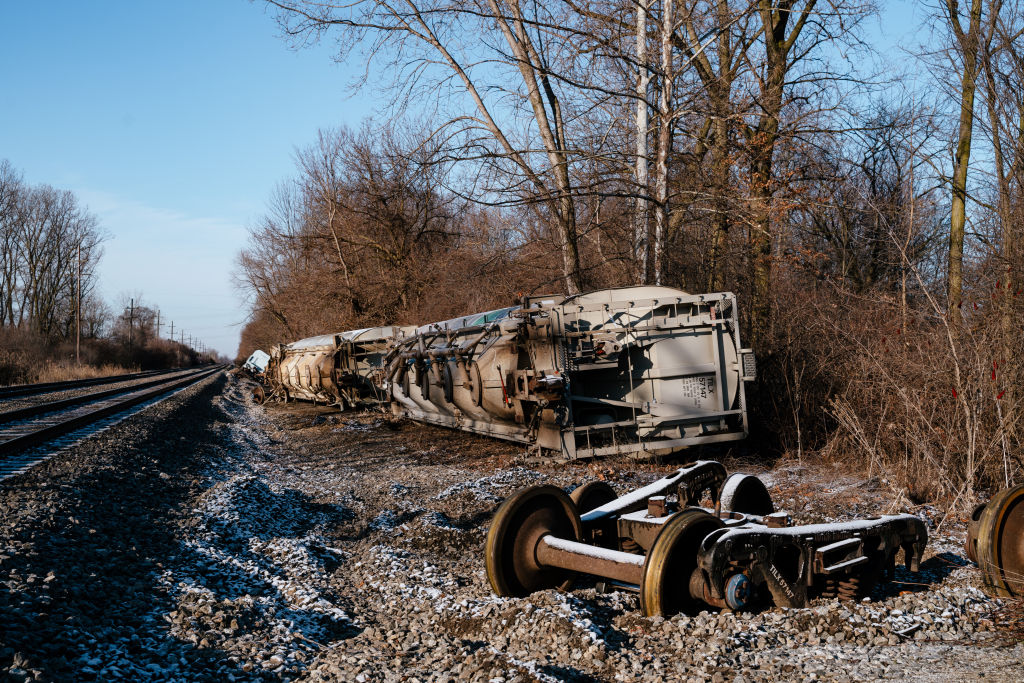Norfolk Southern, the railway company whose train derailed Feb. 3 in East Palestine, Ohio, will face an investigation into its safety measures by the National Transportation Safety Board, officials announced Tuesday.
Federal investigators pointed to five “significant” accidents since Dec. 2021. In the latest incident on Tuesday, a Norfolk Southern conductor was killed after being struck by a dump truck at a facility in Cleveland, Ohio. “The NTSB is concerned that several organizational factors may be involved in the accidents, including safety culture,” the federal agency said in a statement on Tuesday. Of the five accidents highlighted by federal authorities, two included trains that derailed this month.
Train derailments are quite common in the U.S. The Department of Transportations’ Federal Railroad Administration has reported an average of 1,475 train derailments per year between 2005-2021. Despite the relatively high number of derailments, they rarely lead to disaster.
The East Palestine derailment was an exception. The derailment included cars carrying vinyl chloride, which is used to make plastic products and can cause cancer at high levels of exposure. In an effort to avoid an explosion, the railroad burned the chemical. The derailment led to the evacuation of the Ohio town, as well as concerns about air and water quality.
Federal, state and local officials are still investigating, but so far have maintained that the drinking water and the air is safe—even as a major grocery chain pulled its water that was bottled from a spring 25 miles away. Some residents reported symptoms of dizziness, headaches and rashes. Experts say it’s unlikely that toxic chemicals could have spread beyond a one-mile radius from the crash site.
The East Palestine derailment, however, has increased attention on railroad safety—and led to questions about whether deregulation has made the railroad industry less safe.
How common are train derailments?
The Department of Transportation has registered more than 12,400 train derailments over the past decade and of these accidents, roughly 6,600 tank cars were carrying hazardous materials and 348 cars released their contents, according to the Associated Press.
Annual fatalities from derailments have been in single digits since 1993; there were no fatalities caused by derailments from 2018-2020 and in 2021 there were three deaths, according to Department of Transportation data. The agency reported 83 injuries related to derailments in 2021, 28 in 2020 and 21 in 2019.
An analysis from the Eno Center for Transportation found that less than 1% of railroad incidents involving fatalities occur because of a derailment; the most common reasons for fatalities are trespassing on railroads and trains colliding with vehicles.
Other recent train derailments
On March 4, Norfolk Southern—the same rail company involved in the East Palestine derailment—had a train of 212 cars derail in Springfield, Ohio. Kraig Barner, a general manager for Norfolk Southern, said Sunday that 28 of the train’s cars had derailed, the New York Times reported.
This time, the consequences were not as severe and the crash entailed no risk to the public, officials noted. Ohio Governor MikeDeWine said no hazardous chemicals were on the train, although residents were temporarily requested to shelter in place.
Another incident occurred in Trinway, Ohio on Jan. 19 when dozens of train cars derailed on the Ohio Central Railroad. Local officials said the cars were empty and no leaks occurred, the Zanesville Times Recorder reported.
At least three derailments occurred in South Carolina this year in Lake City, near Loris and in Enoree. No injuries were reported, although in the Lake City incident, the train hit an unoccupied car that was on the train tracks.
On Feb. 18, a train derailed in Belle Ville, Mich.—with six train cars out of 30 crashing off the tracks, Reuters reported.

Calls for greater safety measures
Ohio lawmakers are calling for stricter oversight. “The railroad’s got a lot of questions they’ve got to answer and they really haven’t really done it very well yet,” Sen. Sherrod Brown, an Ohio Democrat, told ABC’s This Week on Sunday. Brown and fellow Ohio Sen. JD Vance, a Republican, have introduced a bill that would require increased planning for disasters as well as limits on train size and weight.
Norfolk Southern announced plans for safety upgrades Monday that included using detectors along railroad tracks to anticipate overheating before it leads to a disaster. The company has said that it plans to add about 200 hot bearing detectors to its network.
In the East Palestine derailment, investigators learned that hot bearing sensors had flagged high temperatures before a wheel failed on a train car, it but took too long to alert the train crew, according to a Feb. 23 National Transportation Safety Board report.
The Federal Railroad Administration has highlighted the importance of these detectors in the aftermath of recent derailments—as well as ensuring they are adequately inspected by employees; the agency has said overheating bearings were to blame for four other derailments since 2021, according to the AP.
However, experts such as Professor Allan Zarembski, who leads the University of Delaware’s rail engineering and safety program, told the AP that they only cause a handful of the many derailments each year so it’s important to go beyond a “knee-jerk reaction.”
More Must-Reads from TIME
- Donald Trump Is TIME's 2024 Person of the Year
- Why We Chose Trump as Person of the Year
- Is Intermittent Fasting Good or Bad for You?
- The 100 Must-Read Books of 2024
- The 20 Best Christmas TV Episodes
- Column: If Optimism Feels Ridiculous Now, Try Hope
- The Future of Climate Action Is Trade Policy
- Merle Bombardieri Is Helping People Make the Baby Decision
Write to Sanya Mansoor at sanya.mansoor@time.com